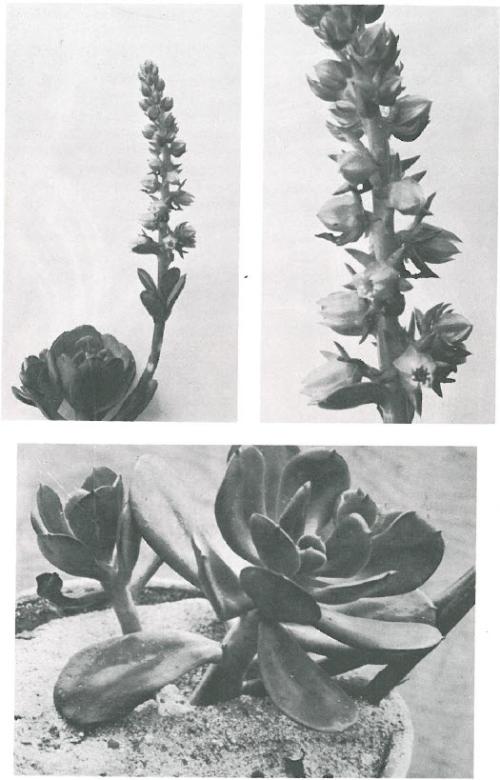VIRIDISSIMA Walther, 1959 (engl./ fr.)
Series Nudae
Type : MacDougall B-134, collected San Pedro Mixtepec, Dist. Miahuatlan, Oaxaca, 10'000 t, between and on scattered rocks, in nearly full light or partial shade from scattered oaks, 1951. CAS 409883.
Etymology : for the bright green leaves.
Distribution : Mexico (Oaxaca: San Pedro Mixtepec area, i.e. a rather limited distribution area); 3000 m.
Description of Echeveria viridissima from the type specimen CAS 409883, photos by Tom MacDougall and recent photos of plants in habitat :
Caulescent plant, branching near the ground, most likely glabrous.
Stems stout, at base more than 1 cm thick.
Rosettes at top of stems of up to fifteen leaves.
Rosette leaves densely arranged, 3.5 – 6.2 cm long and 1.8 – 3.2 cm wide just below apex, obovate-mucronate, shortly petiolate. According to photos of plants in habitat yellowish green with brownish spots and margins and brownish-red underside.
Flowering stems up to 40 cm and more (incl. raceme), according to photos of plants in habitat fiery red. On pressed specimens stem leaves are lacking. Pedicels are somewhat variable, 1.3 – 1.5 cm on lower part of the raceme, shorter on upper part. Occasionally the lower part of the raceme can be paniculate. Flowers rather loosely arranged. Bracts at the base of the pedicels or subtending the flowers ca 1.2 cm long.
Flowers : Sepals short, less than half the length of the corolla, appressed to slightly spreading, corolla 1.1 – 1.3 cm long, according to photos of plants in habitat fiery red outside and yellow inside.
Cytology : n = ± 43
Note :
1. Echeveria viridissima was collected twice by Thomas MacDougall at two fairly close localities.
Walther published his article on E. viridissima in CSJ (Los Angeles) 31: 22-24, 1959. It consists of a detailed text, a sketch and 3 photos. The described plant has leaves 10 cm long and 6 cm wide, bracts 35 mm long, sepals to 20 mm long and a 16 mm long corolla. The sketch shows a rather big corolla with huge recurved sepals. In short, this is a rather big plant with quite respectable flowers - but this is not the plant collected by MacDougall ! The photos however show a plant with leaves only half as long and wide and rather small flowers without huge sepals. And while description and sketch do not correspond at all, the photos are correct. In other words : The protologue is a mixture of contradictionary components. Amazingly no one has noticed this until today. As far as the name is concerned, it may not be really appropriate – photos of plants in habitat do not show a distinctly green plant. In short : The name is fixed to the type, Walther's description titled "E. viridissima" however is not referable to the type, this means the true E. viridissima is lacking a description. Plants currently circulating as E. viridissima are only correctly named if they originated at the type locality. And Walther's description should best be wiped out because it conveys a completely false image of E. viridissima. See also p. 238-239 in Revision of Walther's monograph Echeveria, 1972.
2. The flower photo in Pilbeam, The genus Echeveria, fig. 428, p. 294, 2008, is completely wrong, this is the inflorescence of E. multicaulis ! Whether the plant fig. 427 is correct cannot be known because the flower stalk is cut off.
3. It is not indicated whether the photos by Reyes Santiago & Brachet on www.crassulaceae.com show plants at the type locality of E. viridissima at San Pedro Mixtepec, i.e. whether they are definitely correct for E. viridissima.
Photos of B-134 :

from the protologue, published in Cact. Succ. J. (Los Angeles) 31: 22-24, 1959.